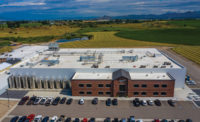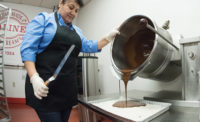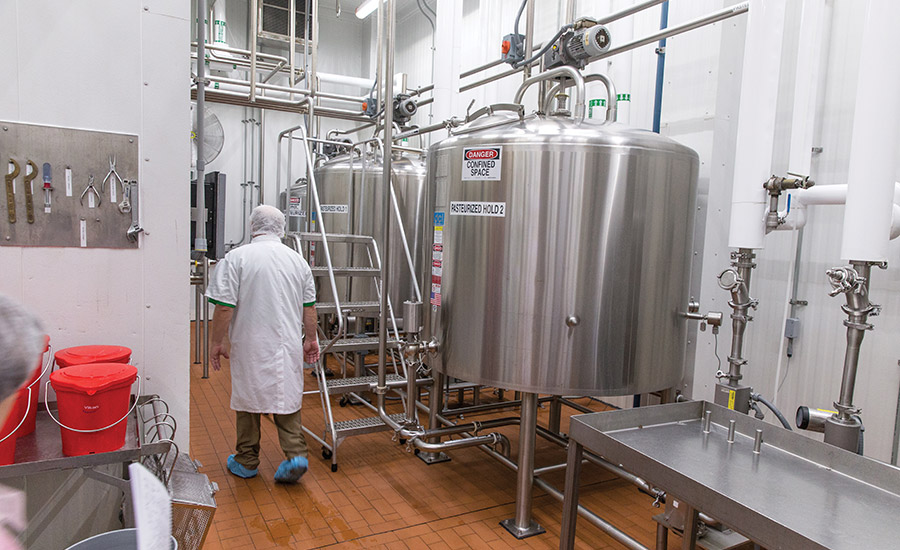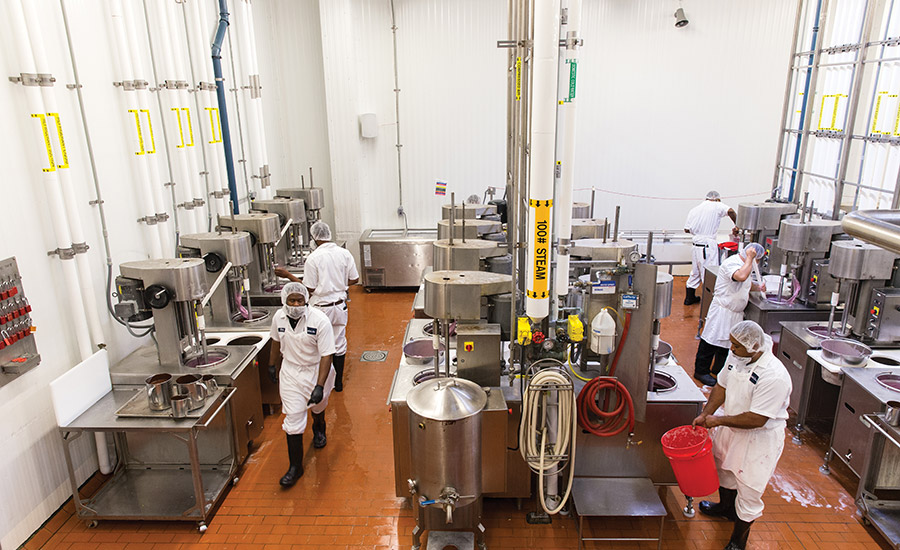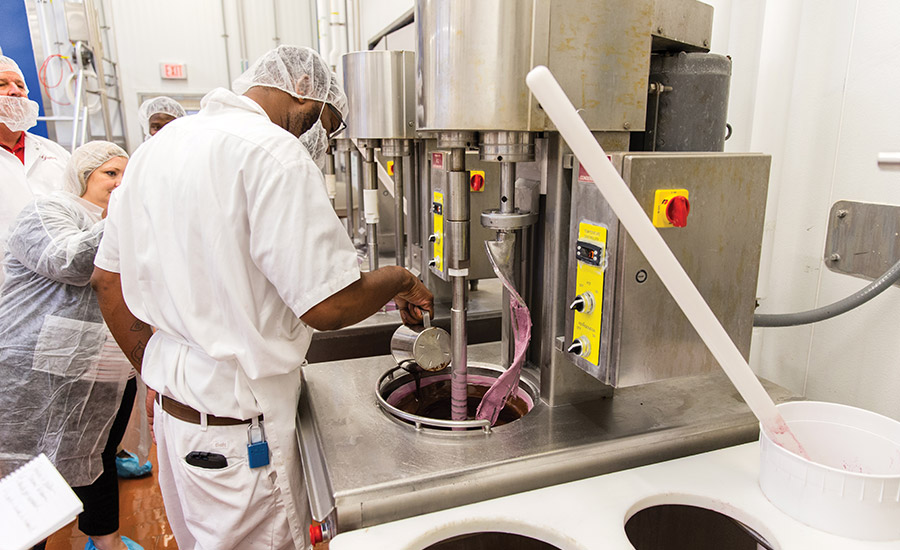Graeter’s ice cream plant is different by design
Graeter’s ice cream plant blends a centuries-old process with modern technology to create an operation that’s like no other


















First-time visitors to the ice cream manufacturing facility operated by Graeter’s Ice Cream — attached to the company’s Cincinnati headquarters on Regina Graeter Way — might be a little surprised when they step inside. For one thing, they would observe a lot more employees hustling and bustling around than they would spot in a typical ice cream plant. They also would spy numerous somewhat peculiar-looking stainless-steel stations, distributed across four and a half rows, housing stainless-steel buckets.
Those station-and-bucket combinations are vat freezers, or modernized French Pots, and they are the main reason the plant employs so many people. Graeter’s has relied on the labor-intensive French Pot process since the company’s founding almost 150 years ago by Louis C. Graeter. (See the Process Profile). The process, which creates just 2 gallons of ice cream per batch, results in “a creaminess that’s completely unlike any other ice cream,” according to Graeter’s.
Blending the old with the new
Graeter’s moved ice cream production from its long-time Reading Road facility into this almost 30,000-square-foot facility in 2010, with room to expand. The company opened up the plant with 16 custom-engineered French Pots, eventually increasing that number to more than 30 to help meet increasing production demands, explained Tom Kunzelman, vice president of manufacturing.
The ice cream-making process begins with the delivery of pasteurized ice cream base, milk and cream, on an almost a daily basis, in 300-gallon totes. The facility also makes certain bases (e.g., peanut butter) and the custard that goes into all of its ice cream, noted Robert Graeter, chief of quality assurance and part of the fourth generation of Graeter family owners/operators.
In the blend room, a high-shear mixer blends sugar and powdered ingredients with the liquid ingredients. The mixture then enters the pasteurizing room, where it is pasteurized (or repasteurized) before being transferred to one of three holding tanks. A mixture can stay in a holding tank for up to 96 hours, Robert Graeter noted.
In the same room, Graeter’s uses two tanks to melt 10-pound bars of confectionary-grade chocolate for the chocolate chips — milk chocolate, semisweet or dark chocolate — that get mixed into roughly two-thirds of its ice cream varieties. The chocolate, mixed with a bit of vegetable oil to enhance meltability, is heated to approximately 145 degrees Fahrenheit, Kunzelman noted, and then is brought down to 88 degrees Fahrenheit. The heating and cooling cycle takes about 3 hours and is completely automated.
Once the chocolate is at the right temperature, it is transferred into heated vats and moved to the production floor. The pasteurized ice cream base mixture, meanwhile, is pumped directly, via overhead piping, to one of two large flavor vats on the production floor. Mixing within the flavor vats requires only five to 10 minutes.
“It’s all slow-metered — the right amount of mix, base and flavors,” Robert Graeter explained.
On the day of Dairy Foods’ visit, plant employees were producing Graeter’s signature flavor: Black Raspberry Chocolate Chip. The company uses black raspberries from Oregon’s Willamette Valley for the popular flavor, working directly with the growers to buy all of the puree at harvest, Robert Graeter said. The puree undergoes a heat treatment, and is concentrated and combined with sugar to make the flavor base. The chocolate chips, meanwhile, are made from gourmet bittersweet chocolate bars. (Graeter’s pays just as much attention to quality when it comes to its vanilla — using its own custom blend of Madagascar vanilla beans, and grinding the beans to include in its vanilla ice cream in lieu of spent beans.)
Once the ice cream is ready to exit the flavor vats, the production becomes much more labor-intensive. Plant employees transfer the product from the vats by hand into the stainless-steel buckets, 2 gallons at a time. They carry the buckets over to the proprietary vat freezers; a brine solution (-19 degrees Fahrenheit) within the units freezes the product as a metal blade scrapes it from the sides of the bucket. The process takes about 15 minutes, Robert Graeter explained.
“It’s the modern version of the French Pot,” he said. “The ice cream has very low overrun, as there’s no air going into it. The process freezes the ice cream colder so it has a creamier texture.”
Once the ice cream is frozen, it is prepared to receive the melted chocolate. Employees pour the chocolate by hand from a cup. It then hardens up, forming a “shell” within the French Pots. That shell is broken up with the metal blade and mixed into the ice cream, Robert Graeter noted. The resulting “chips” vary in shape and size based on the particular plant employee who is working the French Pot.
The finished ice cream is carried over to the packaging area, where employees hand-pack it into containers (on the day of Dairy Foods’ visit, employees were hand-packing pint containers).
After the containers are packed (and also wiped clean by hand), they are placed onto a conveyor system, Robert Graeter explained. At this point, the process once again becomes automated. An automatic lidder tops each container, and an X-ray detector ensures the finished product is free of any foreign objects.
Next, the containers are conveyed to a very large spiral freezer for hardening. They remain there, at a temperature between -30 and -40 degrees Fahrenheit, for approximately 45 minutes before being conveyed to an automatic date coder and then a bundler. Pints are packed eight to a bundle.
After bundling, the containers are conveyed back to the freezer before they are robotically palletized and transferred by forklift to cold storage.
Despite the labor-intensive nature of the actual ice cream-making process, the plant is able to produce an impressive amount of product in a short time.
“We probably do about 3,600 pints an hour,” Kunzelman said. “It’s faster without chips.”
The traditional process rules
Although Graeter’s built the plant with expansion in mind, the last decade brought with it a tremendous amount of growth for the company. So the facility is now at 97.5% capacity, Robert Graeter noted. Approximately 75 employees work in the plant; production takes place five days a week during two 10-hour shifts, with a four-hour sanitation shift in between.
Graeter’s growth necessitated the addition of new equipment beyond the extra vat freezers, as well as supplementary storage.
“In 2013, we also purchased a $300,000, 6,000-square-foot warehouse to help maximize our production capabilities,” Kunzelman said. “Following that, in 2016, we purchased a higher-performing blast freezer and custom-made hardening system.”
Another major recent investment was an enterprise resource planning (ERP) system.
“That helps to lead the way in very high-level forecasting and batching,” Kunzelman explained.
Other improvements consider sustainability. For example, the plant optimized transportation to maximize efficiency and swapped out traditional lighting for more appropriate LED lighting, Kunzelman said. And it uses recyclable pints and plastic cartons for both retail grocery and Graeter’s ice cream stores.
However, efficiency and sustainability still take a backseat to Graeter’s core focus: staying true to its traditional French Pot process.
“Driving efficiency is simply not a priority of ours because we know the authenticity in our ice cream starts with this highly unique method of production,” Kunzelman said. “In essence, that supersedes our need for new and sleek equipment. However, we do consistently invest in tools like [the] effective ERP system.”
A food safety standout
What doesn’t take a backseat to the French Pot process is food safety.
“We have intuitively focused less on technology and more on the fervent employment of food safety practices,” Kunzelman said. “It is of the utmost importance to us, and the tools and resources that have given the Graeter’s plant such a spectacular name in food safety have continued to drive our focus in continuing to pursue it.”
The result? What he calls the adoption of “revolutionary food safety practices.” And that’s been no easy feat, considering that the French Pot technology dates back almost 200 years — to a time when equipment wasn’t designed with food safety in mind.
“Over time and through a rigorous training process for each plant employee, the company has made modifications to the French Pots to make cleaning easier and help prevent buildup of brine in the system,” Kunzelman noted. “To ensure food safety protocol, the pots are torn down and cleaned in impeccable detail daily and reassembled with pristine quality.”
The plant’s director of maintenance even redesigned aspects of the French Pot with food safety in mind, he added.
Moreover, much of the plant’s equipment, including everything in the pasteurization room, can be thoroughly cleaned in place via a skid-mounted clean-in-place system, Robert Graeter explained.
When it comes to monitoring those cleaning efforts, a full-scale environmental monitoring program and sanitation verification program are in place. An in-house quality lab, meanwhile, performs product and ingredient bacterial analysis, allergen testing and more.
Product quality is also a major focus.
“We consistently and randomly pull samples from the line multiple times a day, ensuring our quality standards are met,” Kunzelman said. “In each of those quality checks, we check for things like weight, chip size and that the appropriate amount of inclusions are mixed in.”
Gearing up for growth
On the cusp of its 150th birthday, Graeter’s is gearing up for “careful growth” in the near-term, Richard Graeter, president and CEO noted. The plant is well-positioned to accomplish that growth, but is not without a couple of challenges.
One challenge is that the facility is nearing capacity. Robert Graeter said he’d welcome, for example, a freezer addition.
“We do a lot of offsite storage right now,” he said.
And like many other manufacturing operations, hiring and retaining employees can be a stumbling block — perhaps even more so for Graeter’s because of the labor-intensive nature of many of the employees’ positions. (As Kunzelman noted, the plant typically does not cross-train employees across departments, outside of shift leaders and a handful of others, to perform multiple roles because each process is so specialized.)
“It’s hard work,” Robert Graeter stressed. “It’s physical work. They’re on their feet for 10 hours; they’re using their arms and carrying things.”
He added that Graeter’s has a “very detailed” training program in place on the manufacturing side that covers manufacturing skills, food production and food safety. And employees are able to apply those skills if and when they choose to move on.
“The average employee tends to be younger. But they learn good skills here and get a work history and a reputation as a reliable person and worker,” Robert Graeter said.
If its recent performance related to Food Safety Modernization Act (FSMA) compliance is any indication, Graeter’s should have no problem addressing these challenges. FSMA compliance was probably the company’s single biggest investment during the last five years, Robert Graeter noted.
“It was a challenge, but one that we rose to meet,” added Richard Graeter. “And we actually exceeded expectations.”
Looking for a reprint of this article?
From high-res PDFs to custom plaques, order your copy today!




